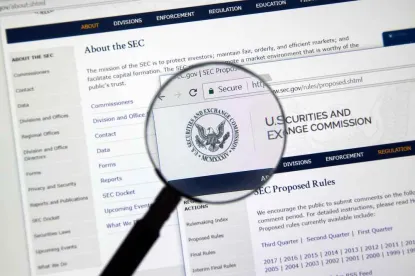-
SEC proposes comprehensive climate-related disclosure rules for public companies in their registration statements and periodic reports.
-
If finalized, compliance dates would begin as early as fiscal year 2023 for certain registrants.
-
Public comment period on proposed rules is open until May 20, 2022.
-
Many commentators have asked the SEC to give the public more time to comment given the breadth of the proposals.
-
Although not final yet, public companies and those contemplating going public in the near future may wish to begin considering their current and prospective disclosure obligations under these proposed rules.
After much anticipation, on March 24, 2022, the Securities and Exchange Commission (SEC) proposed a series of new and extensive disclosure rules that would require all registered companies, including foreign private issuers, to include detailed climate-related information in their registration statements and periodic reports, and climate-related financial statement metrics in a note to their audited annual financial statements. Accelerated and large accelerated SEC reporting companies would also be required to engage an independent outside expert to provide an attestation report relating to additional quantitative disclosure on greenhouse gas (GHG) emissions. The proposed rules are intended substantially to enhance and standardize climate-related disclosures to aid investors in their investment decision-making and were made in response to the growing demand by market participants for increased and consistent disclosures on climate matters. The proposed rules are complex and represent the most comprehensive package of disclosure changes proposed by the SEC in several decades. This GT Alert summarizes the proposed rule amendments, which impact both Regulation S-K as well as the accounting rules of Regulation S-X.
REGULATION S-K
The proposed climate-related rules of Regulation S-K would require disclosure of a company’s (1) governance of climate-related risks; (2) material climate-related impacts on its strategy, business model, and outlook; (3) climate-related risk management; (4) GHG emissions metrics; and (5) climate-related targets and goals, if any.
1. Governance of Climate-Related Risks
The proposed rules would require a company to disclose certain information concerning the board of directors’ oversight of climate-related risks, including:
– The identity of any board members or board committee responsible for the oversight of climate-related risks;
– Whether any board member has expertise in climate-related risks, with disclosure in such detail as necessary to fully describe the nature of the expertise;
– The processes and frequency by which the board or board committee discusses climate-related risks, including how the board is informed about climate-related risks, and how frequently the board considers such risks;
– Whether and how the board or board committee considers climate-related risks as part of its business strategy, risk management, and financial oversight; and
– Whether and how the board sets climate-related targets or goals, and how it oversees progress against those targets or goals, including the establishment of interim targets or goals.
The proposed rules would also require a company to disclose certain information concerning management’s role in assessing and managing climate-related risks, including:
– Whether certain management positions or committees are responsible for assessing and managing climate-related risks and, if so, the identity of such positions or committees and the relevant experience of the position holders or members in such detail as necessary to fully describe the nature of the experience;
– The processes by which the responsible managers or management committees are informed about and monitor climate-related risks; and
– Whether and how frequently such responsible positions or committees report to the board or a committee of the board on climate-related risks.
2. Material Climate-Related Impacts on Strategy, Business Model, and Outlook
Under the proposed rules, companies would be required to describe the climate-related risks likely to have a material impact on the company’s business or consolidated financial statements over the short, medium, and long term. Climate-related risks can relate to the physical impacts of climate change (physical risks) and risks related to a potential transition to a lower carbon economy (transition risks). Disclosure of climate-related risks should define the time horizon, specify the nature of the risks presented, and describe the company’s actions or plan to mitigate or adapt to the risk. Physical risks should be characterized as acute or chronic, and describe the location and nature of the properties, processes, or operations subject to the physical risk. Transition risks should be characterized as relating to regulatory, technological, market, liability, reputational, or other transition-related factors, and describe how those factors impact the company.
Once a company has described the climate-related risks reasonably likely to have a material impact on the company’s business or consolidated financial statements, the company would then be required to describe the actual and potential impacts of those risks on its strategy, business model, and outlook, including impacts on the company’s:
– Business operations, including the types and locations of its operations;
– Products or services;
– Suppliers and other parties in its value chain;
– Activities to mitigate or adapt to climate-related risks, including adoption of new technologies or processes;
– Expenditure for research and development; and
– Any other significant changes or impacts.
The company would also be required to disclose the time horizon for each described impact (i.e., in the short, medium, or long term as defined by the company when determining its material climate-related risks). In addition, the proposed rules would further require a discussion of how the company has considered the identified impacts as part of its business strategy, financial planning, and capital allocation.
If a company uses carbon offsets or renewable energy credits or certificates (RECs) as part of its emissions reduction strategy, the company will need to disclose the role that carbon offsets or RECs play in the company’s climate-related business strategy.
If a company maintains an internal carbon price, it would be required to disclose:
– The price in units of the company’s reporting currency per metric ton of carbon dioxide equivalent (CO2e);
– The total price, including how the total price is estimated to change over time, if applicable;
– The boundaries for measurement of overall CO2e on which the total price is based, if different from the GHG emission organizational boundary requirement; and
– The rationale for selecting the internal carbon price applied.
A company would also be required to describe the resilience of its business strategy in light of potential future changes in climate-related risks. The discussion would have to include a description of any analytical tools, such as scenario analysis, that the company uses to assess the impact of climate-related risks on its business and consolidated financial statements, or to support the resilience of its strategy and business model in light of foreseeable climate-related risks. If a company uses scenario analysis, it will have to disclose the scenarios considered, including parameters, assumptions, and analytical choices, and the projected principal financial impacts on the company’s business strategy under each scenario.
3. Climate-Related Risk Management
The processes a company utilizes for identifying, assessing, and managing climate-related risks would need to be discussed, including, as applicable:
– How the company determines the relative significance of climate-related risks compared to other risks;
– How it considers existing or likely regulatory requirements or policies when identifying climate-related risks;
– How it considers shifts in customer or counterparty preferences, technological changes, or changes in market prices in assessing potential transition risks; and
– How it determines the materiality of climate-related risks, including how the potential scope and impact of an identified climate-related risk is assessed.
When describing any processes for managing climate-related risks, a company would be required to disclose, as applicable, how it:
– Decides whether to mitigate, accept, or adapt to a particular risk;
– Prioritizes whether to address climate-related risks; and
– Determines how to mitigate any high-priority risks.
If a transition plan has been adopted as part of a climate-related risk management strategy, a description of the plan, including the relevant metrics and targets used to identify and manage any physical and transition risks, would be required. Further, a company would need to discuss, as applicable, plans to mitigate or adapt to any identified physical risks, including but not limited to those concerning energy, land, or water use and management. The proposed rules would also require a company that has adopted a transition plan as part of its climate-related risk management strategy to discuss, as applicable, how it plans to mitigate or adapt to any identified transition risk, including:
– Laws, regulations or policies that restrict GHG emissions or products with high GHG footprints, including emissions caps, or require the protection of high conservation value land or natural assets;
– The imposition of a carbon price; and
– Changing demands or preferences of consumers, investors, employees, and business counterparties.
A company would update transition plan disclosure each fiscal year by describing the actions it took during the year to achieve the plan’s targets or goals.
Further, transition plan disclosure could, but would not be required to, include how the company plans to achieve any identified climate-related opportunities, such as:
– The production of products that may facilitate the transition to a lower carbon economy, such as low emission modes of transportation and supporting infrastructure;
– The generation or use of renewable power;
– The production or use of low waste, recycled, or other consumer products that require less carbon-intensive production methods;
– The setting of conservation goals and targets that would help reduce GHG emissions; and
– The provision of services related to any transition to a lower carbon economy.
4. GHG Emissions Metrics
The proposed rules would require a company to disclose its GHG emissions for its most recently completed fiscal year. The proposed rules would establish certain requirements regarding the measurement and reporting of GHG emissions that would promote the comparability of such disclosure. The proposed rules would define:
– “Scope 1 emissions” as direct GHG emissions from operations owned or controlled by a company;
– “Scope 2 emissions” as indirect GHG emissions from the generation of purchased or acquired electricity, steam, heat, or cooling consumed by operations owned or controlled by a company; and
– “Scope 3 emissions” as all indirect GHG emissions not otherwise included in a company’s Scope 2 emissions, which occur in the upstream and downstream activities of a company’s value chain. Upstream emissions include emissions attributable to goods and services that the company acquires, the transportation of goods, and employee business travel and commuting. Downstream emissions include the use of the company’s products, transportation of products, end-of-life treatment of sold products, and investments made by the company.
Under the proposed rules, all companies would be required to disclose their Scope 1 and Scope 2 emissions, but Scope 3 emissions would only need to be disclosed if those emissions are material, or if the company has set a GHG emissions reduction target or goal that includes its Scope 3 emissions. Smaller reporting companies would be exempt from, and would not need to comply with, Scope 3 disclosure requirements. Examples of where Scope 3 emissions may be material include:
– If an industry is in the process of transitioning to lower-emission products or processes that may result in financial risks;
– If a company is required to allocate capital to invest in lower emissions equipment; or
– If scope 3 emissions make up a relatively significant portion of a company’s overall GHG emissions.
The SEC has proposed a safe harbor to apply with respect to any statement regarding Scope 3 emissions. Such statement would not be deemed fraudulent unless it is shown that such statement was made or reaffirmed without a reasonable basis or was disclosed other than in good faith.
While the SEC is proposing to exempt smaller reporting companies from the Scope 3 disclosure requirements, smaller reporting companies may still need to provide such disclosures to larger companies if they are part of that company’s upstream or downstream activities. The Scope 3 disclosure requirements may also have an impact on private companies and foreign companies not subject to the regulation, as many are part of companies’ upstream and downstream activities.
Independent Expert Attestation Report. A company required under the proposed rules to provide Scope 1 and Scope 2 emissions disclosures and that is an accelerated filer or a large accelerated filer would also be required to include an attestation report covering such disclosure in the relevant filing, subject to a phase-in transition period. The GHG emissions attestation report must be prepared and signed by a GHG emissions attestation provider who:
– Is an expert in GHG emissions by virtue of having significant experience in measuring, analyzing, reporting, or attesting to GHG emissions; and
– Is independent with respect to the company, and any of its affiliates, for whom it is providing the attestation report, during the attestation and professional engagement period.
The GHG emissions attestation report would be required to include the following:
– An identification or description of the subject matter or assertion being reported on, including the point in time or period of time to which the measurement or evaluation of the subject matter or assertion relates;
– An identification of the criteria against which the subject matter was measured or evaluated;
– A statement that identifies the level of assurance provided and describes the nature of the engagement;
– A statement that identifies the attestation standard (or standards) used;
– A statement that describes the company’s responsibility to report on the subject matter or assertion being reported on;
– A statement that describes the attestation provider’s responsibilities in connection with the preparation of the attestation report;
– A statement that the attestation provider is independent; and
– For a limited assurance engagement, a description of the work performed as a basis for the attestation provider’s conclusion.
5. Climate-Related Targets and Goals
If a company has set any climate-related targets or goals, then the proposed rules would require the company to provide certain information about those targets or goals. Specifically, the rules would require it to disclose, as applicable, a description of:
– The scope of activities and emissions included in the target;
– The unit of measurement, including whether the target is absolute or intensity-based;
– The defined time horizon by which the company intends to achieve the target, and whether the time horizon is consistent with one or more goals established by a climate-related treaty, law, regulation, policy, or organization;
– The defined baseline time period and baseline emissions against which progress will be tracked, with a consistent base year set for multiple targets;
– Any interim targets the company sets;
– How the company intends to meet its climate-related targets or goals.
The proposed rules would further require a company to discuss how it intends to meet its climate-related targets or goals, and update its disclosures each fiscal year to indicate whether it is making progress toward meeting the target or goal and how such progress has been achieved. If a company has used carbon offsets or RECs as part of a plan to achieve climate-related targets or goals, the company would be required to disclose the amount of carbon reduction represented by the offsets or the amount of generated renewable energy the RECs represent, the source of the offsets or RECs, a description and location of the underlying projects, any registries or other authentication of the offsets or RECs, and the cost of the offsets or RECs.
REGULATION S-X
The proposed climate-related provisions under Regulation S-X would require a company to disclose in a note to its financial statements certain disaggregated climate-related financial statement metrics falling under the following three categories of information: (1) financial impact metrics; (2) expenditure metrics; and (3) financial estimates and assumptions.
The proposed rules would require disclosure of the financial impacts from severe weather events and other natural conditions, such as wildfires, flooding, drought, extreme temperatures, etc. The proposed rules would require disclosures of expenditures to mitigate risks of severe weather events and natural conditions on business operations, such as amounts incurred to relocate assets from areas at high risk from wildfires. Finally, the proposed rules would also require disclosure of the financial impact of transition activities, such as efforts to reduce GHG emissions or otherwise mitigate exposure to transition risks on any relevant line items in the financial statement.
TRANSITION PERIODS
If adopted, the proposed rules would provide a transition period for all registrants based upon status as a large accelerated, accelerated, and non-accelerated, or smaller reporting company. Assuming the rules are adopted in 2022, then a registrant with a Dec. 31 fiscal year end would be subject to compliance in annual reports for all disclosures except Scope 3 commencing with the Annual Report on Form 10-K for fiscal year 2023 for large accelerated filers (fiscal 2024 for accelerated and non-accelerated filers; fiscal 2025 for smaller reporting companies). Scope 3 disclosures would be required with effect from the subsequent fiscal year (2024 for large accelerated filers and 2025 for accelerated and non-accelerated filers), except for smaller reporting companies, which would be exempted from the Scope 3 disclosure requirements.
The proposed rules would apply to both domestic registrants and foreign private issuers (FPIs), as the SEC believes disclosure by FPIs would be important to achieving the goal of more consistent, reliable, and comparable information across registrants. The SEC has specifically requested comment on how FPIs should be treated under the new rules. For example, the SEC has asked whether they should limit the extent to which the requirements apply to FPIs already subject to substantially similar requirements in their home jurisdictions.
Although still in the form of proposed rules which are subject to public comment and not final, given the significance of the additional disclosures that will inevitably be required, public companies may wish to consider beginning the process of analyzing what they will be required to do. To start, this would include determining what information the company currently collects and discloses, together with analyzing whether any metrics currently calculated would comply with what are expected to be the proposed technical disclosure requirements and their ability to be attested to by third parties. Further, public companies may review existing goals and targets communicated by the company publicly and to third parties and consider potential disclosure obligations when setting new targets or goals, including for Scope 3 GHG emissions. The company’s approach to governance of climate-related risks ought to be evaluated in light of the proposed rules with a view to potentially adopting new or enhanced risk management structures for oversight of these risks. The company’s audit committee may also consider communicating with the company’s external auditors to understand how the proposed rules, if adopted, will impact the preparation and presentation of the company’s financial statements.
There will be no one-size-fits-all solution for developing compliance systems under the proposed new rules. Regulated entities may wish to engage experienced environmental and securities counsel and consultants early to ensure accounting and reporting systems are in place if the rule becomes final.





 />i
/>i

